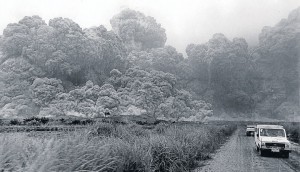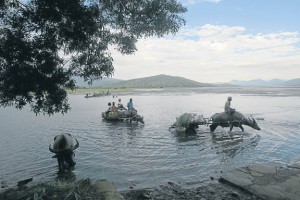Pinatubo at 20: Rebuilding still unfinished
(First of two parts)

YESTERDAY Photojournalists in their company vehicles race against volcanic fury when burning ash from Mt. Pinatubo threatened to engulf them in Barangay Oguec, Botolan, Zambales, in this photo nervously taken by Boy Cabrido on June 15, 1991. INQUIRER PHOTO
For 60-year-old Linda Baking and her husband, recovering from the disaster has hardly begun. Rebuilding—for them and some others—remains an unfinished task.
Already, the government has spent some P50 billion for the rehabilitation of areas in three provinces wrecked by the June 15, 1991, volcanic blasts.
Yet to date, the government has not tasked any agency or created any body to take stock of successes or limitations, of lessons learned, or to measure accountability or decide future actions, an Inquirer check showed.
The Mount Pinatubo Commission could no longer be counted on. Its extended life ended in 2001.
Article continues after this advertisementBased on past documents that tackled disaster-related issues, a government evaluation appears called for.
Article continues after this advertisementNo to dependency
For instance, sociologists have warned against breeding dependency so that the people themselves can participate in long-term development. Agriculturists have stressed the urgency of reviving farms and ponds for food security.
Agrarian reform advocates favor land distribution. Some institutions have called for genuine integration of disaster management in development planning.
In the absence of any official assessment by the government, the Inquirer turned to farmers, Aetas and local leaders for answers. It also asked the National Economic and Development Authority and the Department of Public Works and Highways for a report on interventions and their impacts.
Taking a gamble

TODAY The photojournalists who outraced death while covering the eruption of Mt. Pinatubo 20 years ago returned to Barangay Oguec, Botolan, Zambales, on Monday and came upon this bucolic scene of farmers driving their carabao-drawn carts across a shallow expanse of water, the same spot where the photograph above was shot on June 15, 1991. BOY CABRIDO/CONTRIBUTOR
The Bakings said they were “barely starting” with recovery.
Last year, they moved back to Barangay Talba in Bacolor town to resume farming on a 4-hectare land they obtained through agrarian reform before the 1991 eruptions. They left a house the government had given them at a resettlement site in Madapdap, 40 kilometers from Talba, turning it over to their three children, who work as laborers and pedicab drivers.
The Bakings are taking a gamble because rice farming is not suitable on land covered with lahar, or volcanic mudflows.
Lands in Talba are not very fertile, said Alejandro Nuqui.
Village at risk
The Bakings and the Nuquis are among the seven families now living in Talba. Some 4,000 other families still live in resettlement sites located in urban areas, Nuqui said.
The village remains at risk. The dike is made only of sand and some 100 meters on its stretch have not been plugged.
“At least we have a land to till. In Madapdap, we hardly got by. We hope life is better here,” Baking said.
“We haven’t bounced back. There has been no good source of income,” Nuqui said. “[Rebuilding] isn’t over yet.”
Absence of livelihood
Benigno Tolentino and his wife Clarinda share the same sentiment.
Tolentino, 72, believes the rebuilding process for farmers like him has been delayed by the “absence of livelihood and farmlands in resettlement areas and little help from government.”
Old-timers at the Department of Agriculture said the government should not be blamed. They said helping farmers in danger zones was like encouraging them to stay there.
The Tolentinos left the Bulaon resettlement site and returned to Barangay Duat 10 years ago. By doing so, they moved closer to danger because Duat is near the transverse dike of the FVR Megadike.
The government built the U-shaped, 56-km dike to trap lahar within the Pasig-Potrero River and prevent this from spilling to the Pampanga capital of San Fernando.
The dike slows the flow of water and lahar downstream.
Clarinda, 69, likes it in Duat because her family has a steady supply of vegetables to eat and sell. She also maintains a small store there.
Bacolor situation
But Pedro Garcia, 72, could not return to grow rice in Duat. The eruptions stalled agrarian reform in the town, preventing him from owning the 4 ha he had tilled for 30 years.
Most landowners rent out their plots to big-time sugarcane growers.
Bacolor has not totally recovered, said former Pampanga Board Member Nilo Caballa.
“Much of the population is still dispersed in resettlements,” Caballa said.
“We were agricultural-based before so many tenants are unsure of their tenure in big tracts of lands. The big landlords are absent. Many (tenants) don’t have money to grow crops or fish. Many are already old. There are few jobs in the town.”
Caballa is leading campaigns to save Bacolor from being consigned as a catch basin of lahar to save San Fernando, the commercial capital.
“On a scale of 1 to 10, Bacolor is just 4 insofar as rebuilding is concerned,” he said.
Aetas still poor
Living next to sources of opportunities, such as the Clark Freeport and the Clark Special Economic Zone (Sacobia subzone), does not guarantee that a community can return to a normal life or do better, according to Aeta elders.
Juan Tanglao, 70, and Nenita Sibal, 65, said they remained poor although the lands in Clark were within their ancestral domain.
Clark Development Corp. (CDC) gives them little help and is a party to their displacement, they said. The CDC charter allows it to develop the 4,400-ha main zone and the 35,000-ha Sacobia subzone.
CDC officials complain of difficulty in negotiating with Aetas either because they are not united or unable to articulate well what they want.
Ancestral domain
Aeta elder Juanito Laxamana, 72, said Congress had not settled the issue of whether Clark, a former US military base, was an ancestral domain of the Aetas.
“While the [National Commission on Indigenous Peoples] gave us a title to over 10,000 ha [in Sacobia], some 70 percent of lots are now titled to lowlanders and the lands are being leased by the CDC to foreign and local investors,” Laxamana said.
Aetas who are organized appear to have fared better.
Mounting the most organized evacuations from Botolan ahead of the 1991 eruptions, the Lubos na Alyansa ng mga Katutubong Ayta sa Sambales (Lakas) has also built consensus on where the tribe must resettle.
From there, they began a campaign to get a certificate of ancestral domain title for 15,998 ha, including the summit of Pinatubo.
Issued last year, the certificate covers four villages on the upper flanks of Pinatubo in Botolan town and portions of Cabangan, San Felipe and San Marcelino towns. The domain is reserved for 1,302 families or 4,370 Aetas.
They have warded off ecotourism projects by Koreans to preserve the lands for younger Aetas, said Lakas chair Carlito Domulot.
But the few resources they have make efforts to recover from the 1991 eruptions a “mammoth task,” he said.
At mercy of traders
Those in Capas, Tarlac, appear to be using well the resources that Pinatubo’s blast left in its wake.
Some 500 men and women, many of them Aetas in Barangay Sta. Juliana, work as guides, porters and masseurs to tourists. Others earn a living gathering pumice stones for jeans manufacturers.
Their stay in the Pinatubo forests is uncertain owing to the designation of the place as a military reservation and its reuse as a bombing range by American military forces.
Many Aetas have left the resettlement areas for the uplands to grow food and cash crops again.
“The Aetas, up to now, are so poor. We are still at the mercy of traders who dictate the prices. The ancestral domain is still not ours,” tribal leader Nelson Pangilinan said.
(Thursday: Zambales left out in Pinatubo rehab)